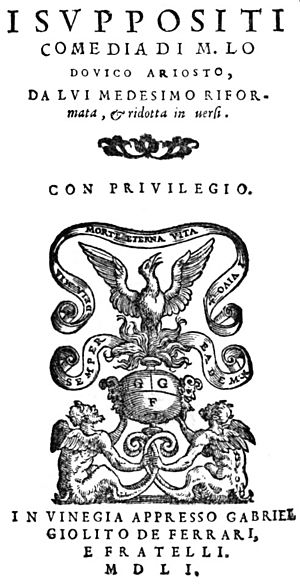Ludovico Ariosto facts for kids
Quick facts for kids
Ludovico Ariosto
|
|
|---|---|
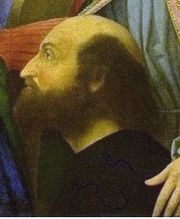
Ariosto, detail of votive painting Madonna with Saints Joseph, John, Catherine, Louis of Toulouse and Lodovico Ariosto by Vincenzo Catena, 1512
|
|
| Born | 8 September 1474 Reggio Emilia, Duchy of Modena and Reggio |
| Died | 6 July 1533 (aged 58) Ferrara, Duchy of Ferrara |
| Language | Italian |
| Nationality | Italian |
| Period | Renaissance |
| Genre | Epic poetry |
| Subject | Chivalry |
| Notable works | Satire, Commedie Orlando Furioso |
| Signature | |
Ludovico Ariosto (born September 8, 1474 – died July 6, 1533) was a famous Italian poet. He is best known for writing the long poem Orlando Furioso (published in 1516). This poem is a type of story called an epic, which means it's a long narrative poem about heroes.
Orlando Furioso continues the story from another poem, Orlando Innamorato. It tells about the adventures of Charlemagne, a famous king, and his knight Orlando. They battle against the Saracens, who were a group of people from the Middle East. The poem also has many side stories.
Ariosto also created the word "humanism" (umanesimo in Italian). This idea focuses on the strengths and potential of people. It was a big part of the Renaissance period.
Early Life and Studies
Ludovico Ariosto was born in Reggio nell'Emilia, Italy. His father, Niccolò Ariosto, was in charge of the local castle. Ludovico was the oldest of ten children. This meant he was expected to take over as the head of his family.
From a young age, Ludovico loved poetry. However, his father made him study law instead. After five years, Ariosto was finally allowed to study classical literature. He learned about ancient Greek and Latin writings. His teacher, Gregorio da Spoleto, later moved to France. Soon after, Ariosto's father passed away.
Working for Important People
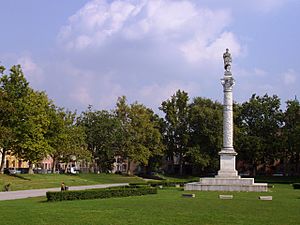
After his father died, Ludovico Ariosto had to stop his studies. He needed to take care of his family, who were having financial problems. Even with these duties, Ariosto still found time to write. He wrote some plays and poems.
His writings caught the eye of Cardinal Ippolito d'Este. A cardinal is a high-ranking official in the Catholic Church. The cardinal took Ariosto under his wing, meaning he became Ariosto's sponsor or "patron." Ariosto became one of the gentlemen in the cardinal's household.
However, the cardinal did not pay Ariosto well. He gave Ariosto very little reward for his great poem, Orlando Furioso. Ariosto had even dedicated the poem to him. The cardinal's only comment was, "Where did you find so many stories, Master Ludovico?" Ariosto later felt that the cardinal was ungrateful. He believed any small payment he got was for running errands, not for his poetry.
Ludovico Ariosto and the famous artist Leonardo da Vinci shared a patron. This was Cardinal Ippolito d'Este's older sister, Marchioness Isabella d'Este. She was known as the "First Lady of the Renaissance." Isabella d'Este is even mentioned in Ariosto's Orlando Furioso. She also appears in a sketch by Leonardo da Vinci.

In 1518, the cardinal went to Hungary. He wanted Ariosto to go with him. But Ariosto made excuses, saying he was sick. He also said he loved to study and needed to care for his elderly mother. The cardinal did not like these excuses. He even refused to meet with Ariosto. This led to a big argument, and Ariosto was fired from his job.
New Jobs and Adventures
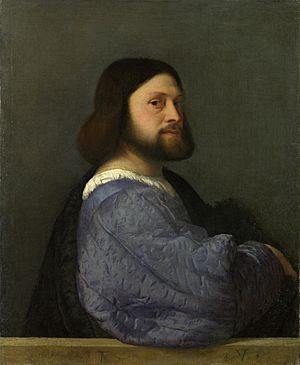
After leaving the cardinal, Ariosto found a new patron. This was Alfonso, the Duke of Ferrara, who was the cardinal's brother. By this time, Ariosto was also known as a diplomat. A diplomat is someone who represents their country or ruler in other places. He had visited Pope Julius II in Rome twice as an ambassador.
One of these trips made him very sick. On his second trip, he was almost killed by the Pope's order. This happened because the Pope was fighting with Duke Alfonso at the time.
Later, because of a war, Ariosto's yearly pay was stopped. He asked the duke for a new job or permission to find work elsewhere. He was then made governor of Garfagnana, a province in the Apennine mountains. He held this job for three years. The area had many conflicts and bandits. Ariosto did not have much support from the duke. Yet, he managed to govern well.
There is a famous story about Ariosto as governor. One day, he was walking alone and met a group of bandits. The bandit leader realized his captive was the author of Orlando Furioso. He then apologized for not showing him respect right away!
In 1508, Ariosto's play Cassaria was performed. The next year, his play I suppositi was first shown in Ferrara. Ten years later, it was performed in the Vatican. This play was later translated into English. It was even used by Shakespeare as a source for his play The Taming of the Shrew.
The first version of Orlando Furioso was published in 1516. It had 40 sections, called cantos. The final version of the poem, with 46 cantos, came out on September 8, 1532.
Ariosto's Writing Style
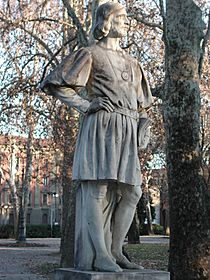
Ariosto often used a special writing technique in his poems. He would stop one story in the middle of a section. Then, he would pick it up again much later in another section. This style is sometimes called "Cantus Interruptus."
Some people think Ariosto did this to build excitement. But others believe he did it to show how people always want stories to be finished. He would break the flow, making readers wait. This can make the reader forget or care less about the first story.
For example, in Orlando Furioso, he writes:
But I, who still pursue a varying tale,
Must leave awhile the Paladin, who wages
A weary warfare with the wind and flood;
To follow a fair virgin of his blood.
This way of writing, where the author talks about the story itself, is part of Ariosto's unique humor. It's sometimes called the "Ariosto's smile." It refers to the clever, slightly funny way he adds comments to his text.
In Books and Movies
The poet Letitia Elizabeth Landon wrote a poem in 1836 called Ariosto to his Mistress. It imagines Ariosto giving his finished Orlando Furioso to a mysterious woman.
Lord Byron, another famous poet, called Ariosto "The southern Scott" in his poem Childe Harold's Pilgrimage (1818). He compared Ariosto to the Scottish writer Walter Scott. This showed how Ariosto's work influenced later European writers.
Ludovico Ariosto also appears in the book version of the video game Assassin's Creed: Revelations. In the story, he becomes an Assassin and takes over as a leader after the main character, Ezio, retires.
In the 1990 movie Mystery Train, a paperback copy of Orlando Furioso can be seen briefly on a table during a dinner scene.
|
See also
 In Spanish: Ludovico Ariosto para niños
In Spanish: Ludovico Ariosto para niños



